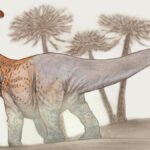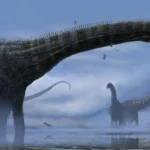The long-necked dinosaurs, also known as sauropods, are some of the most iconic creatures from the Mesozoic era. These massive animals, with their towering necks and enormous bodies, have long captured the imagination of both paleontologists and the public. From the towering Brachiosaurus to the colossal Argentinosaurus, these giants have sparked the question: How did they evolve such long necks?
The evolution of long-necked dinosaurs is a fascinating story of adaptation, survival, and the complex interplay of environmental and evolutionary pressures. In this article, we’ll explore how these extraordinary features came to be and the factors that contributed to the development of such remarkable traits.
The Origins of Sauropods
Long-necked dinosaurs evolved from a group of smaller, early dinosaurs known as the Dinosauria, which includes both theropods (the ancestors of birds) and sauropodomorphs, the early relatives of sauropods. Early sauropodomorphs, such as Eoraptor and Plateosaurus, were much smaller and had more typical dinosaur proportions. These early species were bipedal, meaning they walked on two legs, and had relatively short necks.
However, as time passed, sauropodomorphs began to evolve into the true sauropods, which included the long-necked, quadrupedal (four-legged) giants. This transition took place during the Late Triassic period, roughly 230 million years ago. It is believed that the early ancestors of sauropods started evolving longer necks as a response to ecological pressures such as competition for food, and changes in the environment and available niches.
Why Did Long Necks Evolve?
There are several hypotheses as to why long-necked dinosaurs evolved such extreme necks. The primary reasons include:
- Access to Tall Vegetation: One of the most widely accepted theories is that long necks allowed these dinosaurs to access food sources that were out of reach for other herbivores. With their necks, sauropods could browse on vegetation high in the trees, such as cycads and ferns, giving them a distinct advantage over other herbivores that could only reach lower-growing plants.
- Efficient Foraging: Long necks may also have evolved as a means of increasing the range over which sauropods could forage without having to move their large bodies too much. This allowed them to graze over a wide area, minimizing energy expenditure and reducing the need to constantly roam or compete with other species for food resources.
- Thermoregulation: Some paleontologists propose that the long necks helped with thermoregulation. Larger body size and long necks could have allowed sauropods to control their body temperature more effectively by increasing or decreasing heat absorption through the skin.
- Mating Displays: Another theory is that long necks could have been used for display purposes, especially during mating seasons. Just as some modern animals use physical features like antlers or plumage to attract mates, it’s possible that long necks were used for visual signaling in social interactions or courtship displays.
- Defensive Advantage: The long neck may have offered a defensive advantage. In the event of a predator attack, the ability to rear up on their hind legs or swing their long necks may have deterred carnivorous dinosaurs from attacking.
Evolutionary Pathways and Adaptations
The evolution of long necks in sauropods did not happen overnight. Over millions of years, these dinosaurs underwent significant changes in both their skeletal structure and body size.
1. Neck Lengthening:
As sauropods evolved, their necks gradually lengthened, with key adaptations in their vertebral structure. In the early sauropodomorphs, the neck was relatively short, and the vertebrae were less specialized. However, as evolution continued, the vertebrae of later sauropods became elongated and more flexible, helping to increase the reach of their necks. Over time, they evolved additional neck vertebrae, which contributed to the enormous lengths.
2. Vertebral Modifications:
A remarkable feature in sauropods is the modification of their neck vertebrae. These vertebrae were not just longer but also hollow, containing air sacs, which made the necks lighter despite their impressive length. This adaptation helped reduce the overall weight of the neck, allowing for greater mobility and less energy expenditure while feeding.
3. Body Size and Support:
In parallel with the elongation of their necks, sauropods also grew to enormous sizes. Their massive bodies were supported by thick, pillar-like legs and a strong skeletal structure that allowed them to carry the weight of their long necks. To maintain balance, these dinosaurs developed robust tails that helped counterbalance the neck’s length and weight.

Notable Examples of Long-Necked Dinosaurs
As long-necked dinosaurs evolved, they became some of the largest animals to ever walk the Earth. Some of the most famous and well-studied examples of long-necked dinosaurs include:
- Brachiosaurus: This iconic sauropod is known for its long neck and front legs that were longer than its rear legs, giving it an almost giraffe-like posture. It is believed that Brachiosaurus may have used its neck to feed on vegetation high in trees.
- Apatosaurus: A member of the sauropod family, Apatosaurus had a long neck and tail, with a relatively small head compared to its massive body. This dinosaur was likely a low-browser, feeding on ground-level vegetation, though it could still reach higher foliage.
- Argentinosaurus: Arguably one of the largest dinosaurs ever discovered, Argentinosaurus had an immense neck and body. This colossal herbivore lived during the Late Cretaceous period and grew to lengths over 100 feet, feeding on vast amounts of plant life.
Conclusion
The evolution of long-necked dinosaurs is a prime example of how species adapt to changing environments and ecological pressures over millions of years. From the early ancestors of sauropods to the towering giants that dominated the Mesozoic era, the long neck of these creatures served a variety of functions, from feeding on tall vegetation to potentially aiding in defense or mating.
The development of such unique features highlights the complexity of evolutionary processes and the diverse ways in which life on Earth has evolved to meet environmental challenges. The study of long-necked dinosaurs not only informs us about the past but also provides a glimpse into the dynamic forces that shape the world around us.



